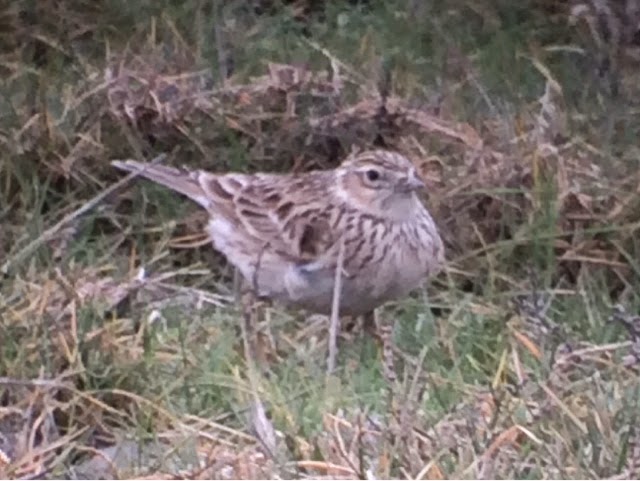There were no brown tones in the fringes to the feathers giving it a much paler look and the primary projection appears very short. I posted these images on twitter and Martin Garner came back with:
So I quickly headed off to look at the relevant Lees and Ball (2011) paper in BB which describes a grey Skylark from Lincolnshire in 1988 which seemingly didnt fit dulcivox. I had a look at this and the Shirihai (1986) Oriental Skylark Paper. The latter was of interest due to the very short primary projection of the bird in question and this being a feature of Oriental Skylark.
Upon reading the RIACT statement and the Lees and Ball paper it became apparent that the primary difference between the various subspecies is the concentration of melanin in the feathers and thus a bird with paler feathers could be an aberrant bird rather than a vagrant from further east. Without trapping the bird and getting some DNA or isotope based fun it would seem it cant really be progressed anywhere.
Then Peter Stronach forwarded me his picture of the Whalsay bird from 2007 which was put forward as a potential dulcivox. The picture reminds me of how I initially saw the bird with the normal Skylark. I kicked myself for not getting both in the frame.
 |
| Whalsay Skylark, 5th October 2007 (Peter Stronach). |
So what to make of it? In old money it seems to fit Alauda arvensis dulcivox for plumage but it could in theory be a pale standard Skylark with a deficiency of melanin. My gut feeling is it is from further east than Bridgwater. I didnt hear anything other than standard Skylark calls which would seem to point against it being Oriental Skylark Alauda gulgula but I cant really work out why it had such a short primary projection. Overall a very interesting bird and one I have learnt plenty from without really resolving much. Any thoughts on its possible identity or point of origin would be gladly received.



2 comments:
Hi James. Interested to read about your Pawlett skylark. I was at Wall Common,Steart on Sat am 21st.Searching half heartedly for Lapland Bunting after very high tide. Came across small flock of skylarks with one seemingly different ,a little paler. Also it lagged behind after the rest of the flock fled.So I took a pic. Thought you might like a look at it to compare with yours as Pawlett is so close to Steart. I thought it was just a juvenile but you may have a different view. I would be interested in your comments. I will try and link you to the photo on my flickr a/c. Bob. AKA lizzardman.https://www.flickr.com/photos/lizzardman606/16645494061/
Hi Bob,
Thanks for your comment. I don't think these are the same bird as yours has rufous tones to the flanks and feather edges and seemingly a dark cheek. My feeling is your bird looked pale as it was fresher than the other birds I.e. The tips of its feathers have abraded away to reveal the breeding plumage which hasn't yet happened to the other birds it was with. Tricky to be sure with such strong light on it though. One difference is your lark has a decent primary projection whereas it seems much shorter in the bird I saw. Interestingly the pale bird from Monday was still present South of the Huntspill today feeding on the Saltmarsh.
Many thanks
James
Post a Comment